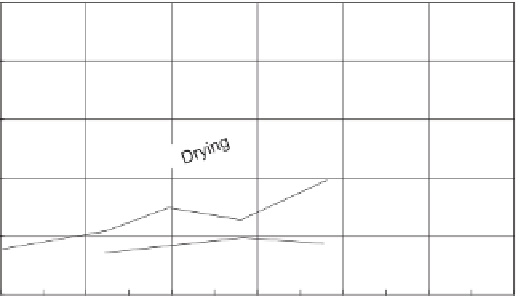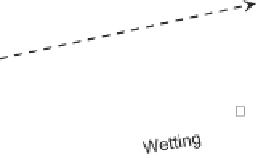Environmental Engineering Reference
In-Depth Information
100
80
60
40
20
0
0
25,000
50,000
75,000
100,000
125,000
150,000
Total suction, kPa
Figure 12.7
Relationship between compressive strength and total suction for kaolin (after
Nishimura and Fredlund, 2002).
In 2006 Garven and Vanapalli published a correlation
between the
κ
parameter and the plasticity index
I
p
of a
soil. As a result, the D.G. Fredlund et al., (1996) equation
could then be used as an estimation equation for the shear
strength of an unsaturated soil.
conditions and residual volumetric water content conditions.
The proposed relationship took the following form:
u
w
)
θ
tan
φ
−
θ
r
c
+
u
a
)
tan
φ
+
τ
=
(σ
−
(u
a
−
θ
s
−
θ
r
(12.3)
where:
12.2.4 Proposed Estimation Equations
for Unsaturated Soil Shear Strength
There are numerous shear strength equations that have
been proposed for the estimation of shear strength for an
unsaturated soil. Most of the equations are empirical and
phenomenological in nature. The equations are based on the
assumption that the shear strength of an unsaturated soil
can be viewed as an extension of saturated shear strength
properties such as
c
and
φ
. The shear strength parameters
c
and
φ
of a soil are considered to be fundamental soil
properties but are also dependent upon initial conditions such
as dry density, water content, and soil structure (Fredlund,
1989a).
Figure12.8 shows twocategories of estimationequations for
unsaturated soil shear strength. Some equations either directly
or indirectly make use of the properties of the SWCC and
others utilize additional information such as soil classification
informationor the shear strengthat residual suctionconditions.
It is clear that the air-entry value of the soil and the residual
suction (or the shear strength at residual suction) form anchor
points for the estimation of unsaturated soil shear strength.
There are also some shear strength estimation equations
that are continuous from zero suction to a high-suction value
whereas in other cases there is one equation from zero suction
to the air-entry value and another equation from the air-entry
value to a high-suction value. Most shear strength equations
are limited tomaximumsoil suctions less than residual suction.
θ
r
=
volumetric water content at residual suction and
(θ
−
θ
r
)
θ
r
)
=
normalized water content
n
(i.e., between satu-
rated volumetric water content and residual vol-
umetric water content).
(θ
s
−
The normalized water content
n
serves as a reduction
term for the soil suction term. The tan
φ
b
term from the
linear Fredlund et al., (1978) equation can be written in a
nonlinear form using normalized water content
n
:
θ
tan
φ
=
−
θ
r
tan
φ
b
n
tan
φ
=
(12.4)
θ
s
−
θ
r
The shear strength associated with soil suction,
τ
s
, can be
written as
u
w
)
θ
tan
φ
−
θ
r
τ
s
=
(u
a
−
(12.5)
θ
s
−
θ
r
12.2.4.2 D.G. Fredlund et al. (1996) Estimation Shear
Strength Equation
Unsaturated soil shear strength equations are related to the
shape of the SWCC. The nonlinearity of the SWCC results
in a nonlinear shear strength relationship (D.G. Fredlund et
al., 1996). The volumetric water content of the soil was writ-
ten in a dimensionless form by dividing by the volumetric
water content at saturation (i.e.,
d
θ/θ
s
). The definition
of unsaturated soil shear strength extends beyond residual
suction conditions. The unsaturated soil shear strength prop-
erty takes the form of a nonlinear function:
=
12.2.4.1 Vanapalli et al. (1996b) Estimation Shear
Strength Equation
Vanapalli et al., (1996b) suggested a shear strength equation
that involved a normalization of the SWCC between saturated
θ
θ
s
κ
tan
φ
b
tan
φ
=
d
tan
φ
=
(S)
κ
tan
φ
=
(12.6)






















Search WWH ::

Custom Search